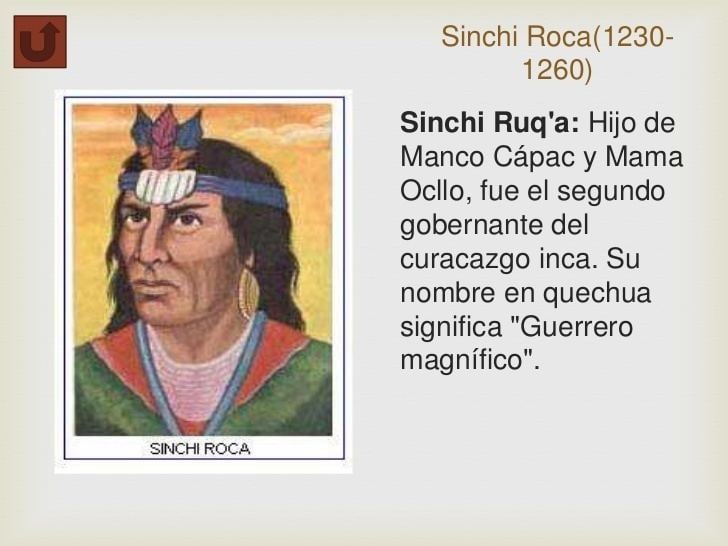Other names Cinchi Roca Spouse(s) Mama Cura (sister) Children Lloque Yupanqui Name Sinchi Roca Grandchildren Mayta Capac | Grandparents Apu Tambo Parents Manco Capac | |
 | ||
Similar People Lloque Yupanqui, Manco Capac, Mayta Capac | ||
inca sinchi roca culmina marat n rpp
Sinchi Roca, Sinchi Rocca, Cinchi Roca (in hispanicized spellings), Sinchi Ruq'a or Sinchi Ruq'a Inka (Quechua for "valorous generous Inca") was the second Sapa Inca of the Kingdom of Cusco (beginning around 1230 CE, though as early as 1105 CE according to some) and a member of the Húrin dynasty.
Contents
- inca sinchi roca culmina marat n rpp
- Fantasma en el colegio sinchi roca
- Family
- Reign
- Building program
- Teuotihi incident
- References

Fantasma en el colegio sinchi roca
Family

He was the son and successor of Manco Cápac and the father of Lloque Yupanqui.

His mother was queen Mama Ocllo (Mama Uqllu), while his wife was Mama Cura, of the lineage Sanu, daughter of Sitic-huaman. They had a son named Sapaca. Manco Capac, Mama Huaco, Sinchi Rocca, and Manco Sapaca erected the House of the Sun.
Reign

The Kingdom of Cuzco later became Tahuantinsuyu (Inca empire) under the rule of Pachacuti. In one of the Inca foundation myths, Sinchi Roca led his family to the valley of Cuzco.
Building program

The chronicler Pedro Cieza de León states that Sinchi Roca built terraces and imported enormous quantities of soil in order to improve the fertility of the valley.
Teuotihi incident

Sinchi is associated with the tale of Teuotihi, an Inca diplomat dispatched to a neighboring kingdom with a crucial message. Upon his arrival, Teuotihi was immediately executed, and his severed head was returned to Sinchi Roca. This act of aggression led to a conflict that culminated in a definitive Inca triumph at the Battle of Mauedipi. While in Inca legend this led to the dominance of Cuzco over the surrounding valleys, archaeological evidence and the testimony of other groups point that the Inca remained of little significance under his rule.
Sinchi came to be used as the title for a mayor or local ruler, while Cápac, one of his father's names, became the title for a warlord.
